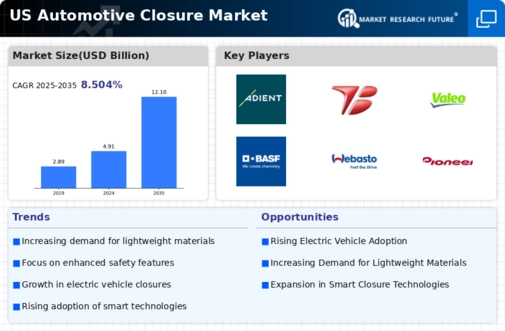The US Automotive Closure Market is characterized by a diverse range of manufacturers and suppliers, each vying for market share through innovation, technology, and strategic partnerships. As the automotive industry evolves with an increasing focus on safety, sustainability, and advanced technology, companies in the closure segment must adapt to shifting consumer preferences and regulatory requirements. Competition is intense, not only from established players but also from new entrants who bring alternative solutions and unique value propositions.
In this landscape, companies invest heavily in research and development to enhance product offerings that include doors, hoods, and trunk lids, while also exploring lightweight materials and smart technologies to improve functionality and efficiency. The market dynamics are influenced by global economic conditions, shifts in automotive demand, and advancements in manufacturing processes, leading to a continuously evolving competitive landscape.Adient holds a significant position in the US Automotive Closure Market, leveraging its expertise in designing and manufacturing seating and interiors.
While primarily recognized for its seating solutions, the company has expanded its capabilities to include various closure technologies that enhance vehicle performance and user experience. Adient's strengths lie in its strong manufacturing footprint and advanced engineering capabilities, enabling it to produce high-quality, customized closure components that meet the stringent demands of original equipment manufacturers. The company emphasizes innovation and has established partnerships with various automotive brands, ensuring it stays relevant amid changing market dynamics. Its ability to adapt to consumer trends, such as the demand for lightweight and sustainable materials, reinforces Adient's competitive edge within the US market.
Toyota Boshoku is another key player in the US Automotive Closure Market, focusing on the development of interior components and closures that contribute to overall vehicle design and functionality. The company produces a wide array of products, including door trims, instrument panels, and other interior elements, all essential to enhancing user comfort and safety. Toyota Boshoku's strong market presence is supported by its deep integration with global automotive manufacturers, particularly those within the Toyota group, allowing for efficient collaboration and alignment of technological advances.
The company's strengths include a commitment to sustainable practices and an emphasis on research and development, ensuring the continuous improvement of its products. Furthermore, Toyota Boshoku has engaged in strategic mergers and acquisitions to strengthen its market position and expand its product lineup, which further solidifies its role in the US Automotive Closure Market. With a focus on high-quality materials and innovative solutions, the company strives to meet the evolving needs of both consumers and automotive manufacturers in the region.






















